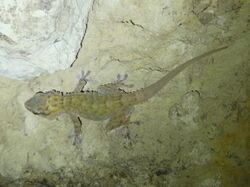Biology:Böhme's gecko
| Böhme's gecko | |
|---|---|

| |
| Scientific classification | |
| Domain: | Eukaryota |
| Kingdom: | Animalia |
| Phylum: | Chordata |
| Class: | Reptilia |
| Order: | Squamata |
| Family: | Phyllodactylidae |
| Genus: | Tarentola |
| Species: | T. boehmei
|
| Binomial name | |
| Tarentola boehmei Joger, 1984
| |
Böhme's gecko (Tarentola boehmei), also commonly known as the Morocco wall gecko,[2] is a species of lizard in the family Phyllodactylidae. The species is native to western North Africa, where it is found in rocky areas such as cliffs and walls as well as ruins of buildings and urban areas.[1][3]
Etymology
Both the specific name, boehmei, and the common name, Böhme's gecko, are in honor of German herpetologist Wolfgang Böhme.[2]
Description
Böhme's gecko is a medium-sized species with a snout-to-vent length (SVL) of 7.5 cm (3.0 in) and a total length (including tail) of about 11 cm (4.3 in). The pupil is a vertical slit, and the eyelids are unable to close over the eye, being replaced by a transparent membrane. The tips of the digits are enlarged, and the whole of the digits are flattened. There is a distinctive rosette of secondary tubercles around the primary tubercles on the flanks, and the nostrils are united on the snout.[4]
Geographic range
Böhme's gecko is found in southern Morocco, northern Western Sahara, and possibly in Algeria[1] and Mauritania.[3] In Morocco it is present in Tazzarine, the southern part of the Anti-Atlas Mountains, the Draa River Valley and Jebel Bani, a lower range of mountains.[1]
Habitat
The natural habitats of T. boehmei are subtropical or tropical dry shrublands and rocky areas. It is also found in rural gardens, and urban areas.[1]
Reproduction
Conservation status
Böhme's gecko has a relatively restricted geographic range but is common in many places within this area. It is tolerant of disturbance to its habitat, the population trend seems steady, and no particular threats have been detected. So the International Union for Conservation of Nature has assessed its conservation status as being of "least concern".[1]
References
- ↑ 1.0 1.1 1.2 1.3 1.4 1.5 Joger, U.; Slimani, T.; El Mouden, H.; Geniez, P. (2006). "Tarentola boehmei". IUCN Red List of Threatened Species 2006: e.T61573A12493946. doi:10.2305/IUCN.UK.2006.RLTS.T61573A12493946.en. https://www.iucnredlist.org/species/61573/12493946. Retrieved 15 November 2021.
- ↑ 2.0 2.1 Beolens B, Watkins M, Grayson M (2011). The Eponym Dictionary of Reptiles. Baltimore: Johns Hopkins University Press. xiii + 296 pp. ISBN:978-1-4214-0135-5. (Tarentola boehmei, pp. 30-31).
- ↑ 3.0 3.1 3.2 Tarentola boehmei at the Reptarium.cz Reptile Database. Accessed 8 February 2015.
- ↑ Trape, Jean-François; Trape, Sébastien; Chirio, Laurent (2012). Lézards, crocodiles et tortues d'Afrique occidentale et du Sahara. Paris: IRD Orstom Editions. pp. 270–271. ISBN 978-2-7099-1726-1. https://books.google.com/books?id=ElwpPK3-hw8C&pg=PA270. (in French).
Further reading
- Joger U (1984). "Taxonomische Revision der Gattung Tarentola (Reptilia: Gekkonidae)". Bonner Zoologische Beiträge 35 (1-3): 129-174. (Tarentola boehmei, new species, pp. 147–149, Figure 3). (in German).
- Rösler H (2000). "Kommentierte Liste der rezent, subrezent und fossil bekannten Geckotaxa (Reptilia: Gekkonomorpha)". Gekkota 2: 28–153 (Tarentola boehmei, p. 116). (in German).
- Schleich HH, Kästle W, Kabisch K (1996). Amphibians and Reptiles of North Africa. Koenigstein, Germany: Koeltz Scientific Books. 630 pp. ISBN:978-3874293778. (Tarentola boehmei, p. 268).
- Sindaco R, Jeremčenko VK (2008). The Reptiles of the Western Palearctic. 1. Annotated Checklist and Distributional Atlas of the Turtles, Crocodiles, Amphisbaenians and Lizards of Europe, North Africa, Middle East and Central Asia. (Monographs of the Societas Herpetologica Italica). Latina, Italy: Edizioni Belvedere. 580 pp. ISBN:978-88-89504-14-7.
Wikidata ☰ Q1019723 entry
 |


